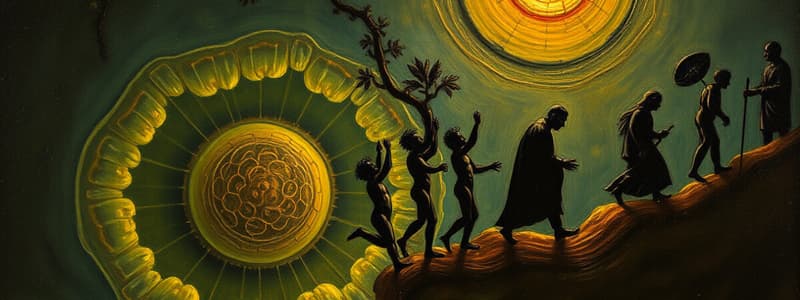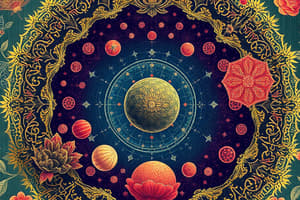Podcast
Questions and Answers
Which characteristic of living organisms specifically relates to their ability to maintain internal stability despite external changes?
Which characteristic of living organisms specifically relates to their ability to maintain internal stability despite external changes?
- Homeostasis (correct)
- Energy production
- Growth and development
- Reproduction
What concept is primarily associated with the idea that species evolve based on their ability to survive and reproduce in their environment?
What concept is primarily associated with the idea that species evolve based on their ability to survive and reproduce in their environment?
- Natural selection (correct)
- Mutation theory
- Adaptive evolution
- Spontaneous generation
According to cell theory, which of the following statements is correct?
According to cell theory, which of the following statements is correct?
- All organisms are made of multiple tissues.
- Only multicellular organisms consist of cells.
- Cells can arise from non-living matter.
- The cell is the fundamental unit of structure and function in living things. (correct)
Which of the following best describes the smallest living form capable of metabolism and reproduction?
Which of the following best describes the smallest living form capable of metabolism and reproduction?
In the context of stem cells, what is a key application associated with their use?
In the context of stem cells, what is a key application associated with their use?
What is the primary function of the nucleolus within the nucleus?
What is the primary function of the nucleolus within the nucleus?
Which statement accurately describes the centrioles?
Which statement accurately describes the centrioles?
What role does the cytoplasm play in cellular functions?
What role does the cytoplasm play in cellular functions?
Which statement best describes mitochondria?
Which statement best describes mitochondria?
What is the primary structure of the cell membrane?
What is the primary structure of the cell membrane?
Flashcards are hidden until you start studying
Study Notes
Introduction to Biology
- Evolution describes the development of various living organisms from earlier forms throughout Earth's history.
- Heritable characteristics of biological populations change over generations.
- Jean Baptiste Lamarck proposed spontaneous generation based on needs and functionalities.
- Charles Darwin introduced survival of the fittest as a mechanism of evolution.
Cell Theory
- A living organism is a complex unit of physicochemical materials capable of self-regulation, metabolism, and reproduction.
- Key characteristics include cellular structure, energy requirements, reproductive capabilities, homeostasis, organization, environmental responsiveness, growth, and material exchange.
Cell Structure and Function
- Cells serve as the basic unit of life, performing essential functions like metabolism, respiration, and reproduction.
- Organelles, found in the cytoplasm, execute various cellular functions and may or may not be membrane-bound.
Organelles
- The cell membrane, composed of a double layer of phospholipids and proteins, controls the entry and exit of materials.
- Cytoplasm is a jelly-like substance where chemical reactions occur and contains organelles.
- The nucleus regulates cell activities, houses DNA in chromosomes, and is encased by a nuclear envelope with pores.
Nucleus and Nucleolus
- The nucleus is the largest organelle containing genetic material and controls cell characteristics.
- The nucleolus, located within the nucleus, produces ribosomes essential for protein synthesis.
Cytoskeleton and Centrioles
- The cytoskeleton maintains cell shape and aids in organelle movement, composed of actin (microfilaments) and tubulin (microtubules).
- Centrioles, found only in animal cells, assist in cell division by forming the mitotic spindle.
Mitochondria
- Known as the powerhouse of the cell, they generate ATP through cellular respiration.
- More abundant in energy-demanding cells, such as muscle cells, and inherit mitochondrial DNA maternally.
Endoplasmic Reticulum (ER)
- ER is a network of hollow membranes involved in synthesizing cell products and transporting them.
- Rough ER is studded with ribosomes for protein production, while Smooth ER synthesizes lipids, regulates calcium, and detoxifies substances.
Ribosomes and Golgi Bodies
- Ribosomes are responsible for protein synthesis; can be attached to Rough ER or free in the cytoplasm.
- Golgi bodies modify, sort, and package proteins from the ER and transport them to their destination.
Lysosomes and Vacuoles
- Lysosomes contain digestive enzymes to break down waste and old cell parts and are involved in autolysis.
- Vacuoles store substances; large central vacuoles are common in plant cells, while animal cells have smaller or absent vacuoles.
Chloroplasts
- Present in plants and algae, chloroplasts convert sunlight into glucose through photosynthesis and contain their own DNA.
- Thylakoids within the chloroplasts are structured for efficient sunlight absorption.
Homeostasis
- Homeostasis is the process of maintaining a stable internal environment suitable for cell function.
- It involves components such as sensors, pathways, integration centers, effectors, and regulatory systems (nervous and endocrine).
Nervous System and Endocrine System
- The nervous system maintains homeostasis by sending nerve impulses to effectors following set point deviations.
- The endocrine system uses hormones secreted into the bloodstream to regulate metabolism and body functions across various systems.
Feedback Mechanisms
- Negative feedback triggers adjustments in physiological measurements to restore equilibrium after deviations from set points.
Studying That Suits You
Use AI to generate personalized quizzes and flashcards to suit your learning preferences.




